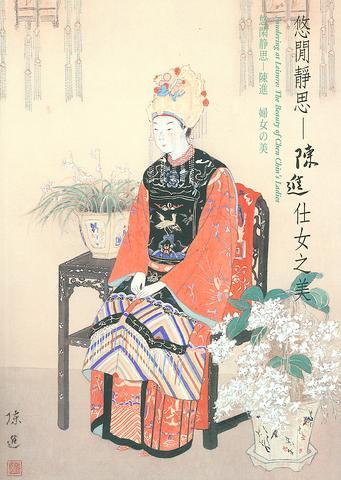Over the coming month, the National Museum of History will be showcasing a selection of works by one of Taiwan's earliest, most celebrated and influential female artists, Chen Chin (
Born in Hsinchu in 1907, Chen was the first Taiwanese female artist to study in Japan. She studied at the Tokyo Fine Arts Girls School under the guidance of some of Japan's leading artists. Even at such a young age her works were so sought after and her style so respected that critics dubbed her "the female genius of the Southern Sea."

PHOTO COURTESY OF NATIONAL MUSEUM OF HISTORY
Chen's repertoire included landscapes and still-life, but it was her portraits of ladies and her ability to transform a painting into an image that incorporated a genuine feel for the era in which they were created that was to prove her enduring legacy.
By the time she passed away in 1998, Chen had become not only one of Taiwan's most prominent and eminent artists, but her works were taking pride of place in museums and galleries throughout Europe and the Americas.
Incorporating 32 of her works dating from 1932 through 1998, The Beauty of Chen Chin's Ladies (
Beginning with Modern Lady, the exhibition takes the viewer through Chen's early unmarried days form between 1925 and 1945. Her eye for detail saw her create works that depicted both the fashions, hairstyles as well as the mannerisms and moods of young ladies of the day.
Works such as her celebrated 1936 Applying Make-up (
The latter part of the exhibition, Traditional Mother deals with Chen's works from 1945 through 1998. Here viewers see how Chen's marriage, motherhood and life as a grandmother changed her outlook on both life and art and saw her style changing in subtle yet noticeable ways.
In later works such as 1968's Fragrant Orchids (
Regardless of which chapter of Chen's life the viewer chooses to enjoy, the current exhibition gives a highly appealing overview of not only the life of one of Taiwan's foremost artists. It is also an interesting insight into the changing fashions and mannerisms of Taiwanese women as see through Chen's eyes.
The Beauty of Chen Chin's Ladies (

This month the government ordered a one-year block of Xiaohongshu (小紅書) or Rednote, a Chinese social media platform with more than 3 million users in Taiwan. The government pointed to widespread fraud activity on the platform, along with cybersecurity failures. Officials said that they had reached out to the company and asked it to change. However, they received no response. The pro-China parties, the Chinese Nationalist Party (KMT) and Taiwan People’s Party (TPP), immediately swung into action, denouncing the ban as an attack on free speech. This “free speech” claim was then echoed by the People’s Republic of China (PRC),

Exceptions to the rule are sometimes revealing. For a brief few years, there was an emerging ideological split between the Democratic Progressive Party (DPP) and Chinese Nationalist Party (KMT) that appeared to be pushing the DPP in a direction that would be considered more liberal, and the KMT more conservative. In the previous column, “The KMT-DPP’s bureaucrat-led developmental state” (Dec. 11, page 12), we examined how Taiwan’s democratic system developed, and how both the two main parties largely accepted a similar consensus on how Taiwan should be run domestically and did not split along the left-right lines more familiar in

Many people in Taiwan first learned about universal basic income (UBI) — the idea that the government should provide regular, no-strings-attached payments to each citizen — in 2019. While seeking the Democratic nomination for the 2020 US presidential election, Andrew Yang, a politician of Taiwanese descent, said that, if elected, he’d institute a UBI of US$1,000 per month to “get the economic boot off of people’s throats, allowing them to lift their heads up, breathe, and get excited for the future.” His campaign petered out, but the concept of UBI hasn’t gone away. Throughout the industrialized world, there are fears that

Most heroes are remembered for the battles they fought. Taiwan’s Black Bat Squadron is remembered for flying into Chinese airspace 838 times between 1953 and 1967, and for the 148 men whose sacrifice bought the intelligence that kept Taiwan secure. Two-thirds of the squadron died carrying out missions most people wouldn’t learn about for another 40 years. The squadron lost 15 aircraft and 148 crew members over those 14 years, making it the deadliest unit in Taiwan’s military history by casualty rate. They flew at night, often at low altitudes, straight into some of the most heavily defended airspace in Asia.